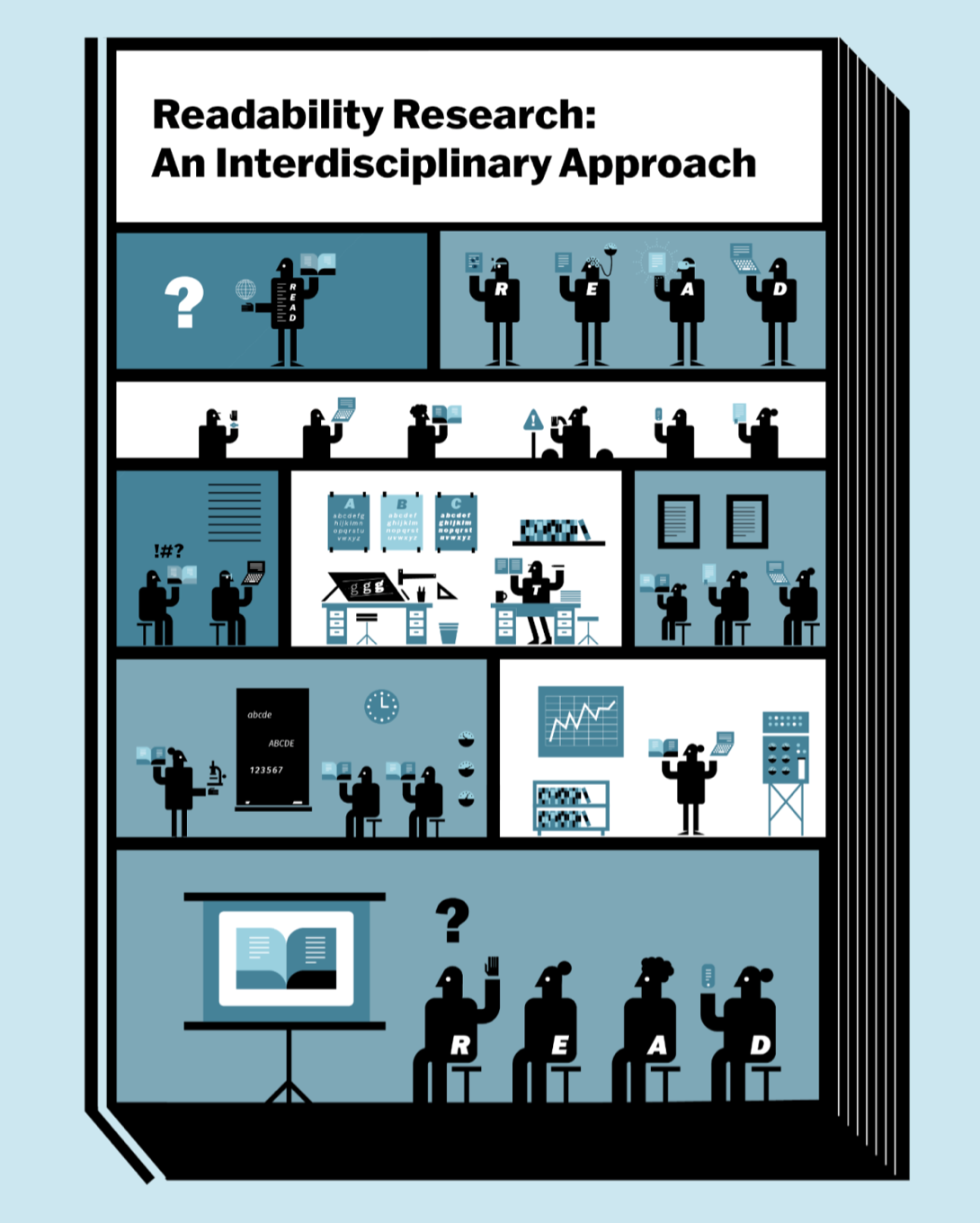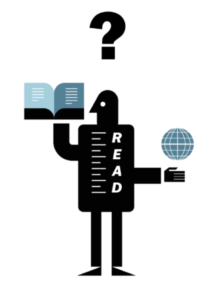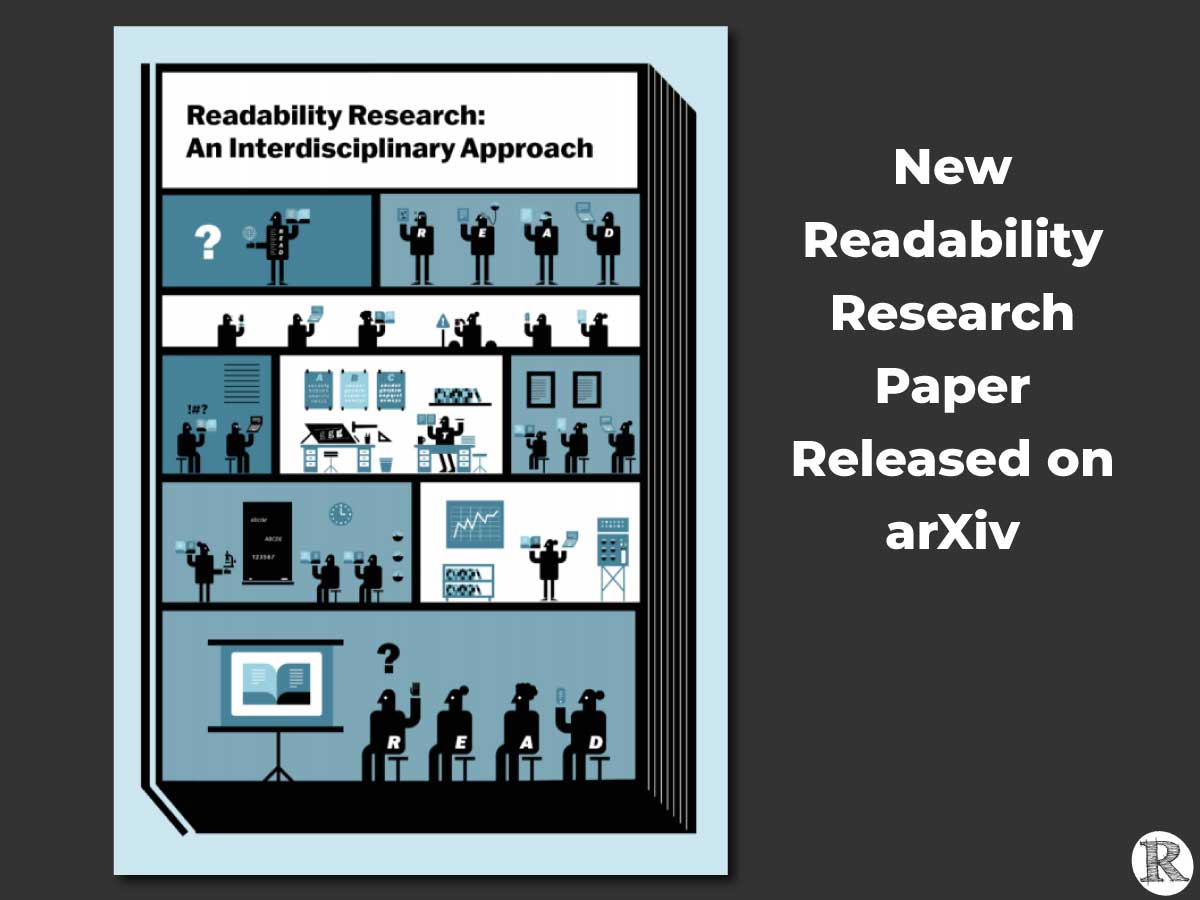“Readability Research: An Interdisciplinary Approach” is now available on arXiv!
“Readability Research: An Interdisciplinary Approach” is now available on arXiv, an archival preprint service. Twenty-eight different authors — from around the world and across many disciplines — collaborated to author a 60+ page intro to Readability research toward the goal of accelerating best practices and methodologies.
The authors welcome your suggestions on this preprint while the paper is in review.
A special thanks to Dr. Zoya Bylinskii for her vision and leadership in producing this collaborative work and to the editorial team, Zoya along with Dr. Ben Sawyer and Dr. Benjamin Wolfe.
The full paper is available here: https://arxiv.org/abs/2107.09615
Readability Research: An Interdisciplinary Approach
Sofie Beier, Sam Berlow, Esat Boucaud, Zoya Bylinskii, Tianyuan Cai, Jenae Cohn, Kathy Crowley, Stephanie L. Day, Tilman Dingler, Jonathan Dobres, Jennifer Healey, Rajiv Jain, Marjorie Jordan, Bernard Kerr, Qisheng Li, Dave B. Miller, Susanne Nobles, Alexandra Papoutsaki, Jing Qian, Tina Rezvanian, Shelley Rodrigo, Ben D. Sawyer, Shannon M. Sheppard, Bram Stein, Rick Treitman, Jen Vanek, Shaun Wallace, Benjamin Wolfe
Readability is on the cusp of a revolution. Fixed text is becoming fluid as a proliferation of digital reading devices rewrite what a document can do. As past constraints make way for more flexible opportunities, there is great need to understand how reading formats can be tuned to the situation and the individual. We aim to provide a firm foundation for readability research, a comprehensive framework for modern, multi-disciplinary readability research. Readability refers to aspects of visual information design which impact information flow from the page to the reader. Readability can be enhanced by changes to the set of typographical characteristics of a text. These aspects can be modified on-demand, instantly improving the ease with which a reader can process and derive meaning from text. We call on a multi-disciplinary research community to take up these challenges to elevate reading outcomes and provide the tools to do so effectively.
Keywords: reading, text, document, information processing, typography

Figure 1. Readability is aspects of visual information design which impact information flow from the page to the reader. It can be enhanced, for example by targeted changes to typographical characteristics, or to content. A growing group of researchers are working to understand how and why these changes help.
1. Introduction

Figure 2. Digital technologies allow dynamic, adaptive reader control of font size, font choice, screen polarity, spacing, and content itself, aspects traditionally controlled by the publisher. New digital technology enables such changes on-demand, instantly enhancing individual readability.
Readability (Fig. 1) is a growing focus because reading has fundamentally changed (Fig. 2). The amount of reading content available today is more than has ever existed, and it grows at an ever-increasing rate. The pressure to ingest vast quantities of information quickly has never been greater. Additionally, reading content is distributed across highly variable publishing platforms, which has changed what and how we read. The wider commercialization of smartphones, e-books, and lightweight laptops over the last 15 years have diversified where and when we read. Now more than ever, improving the modern reading experience has enormous practical and societal significance.
Modern reading is digital, and this has introduced a fundamental paradigm shift. To date, authors, publishers, and designers have been in control of the reading experience. This is no longer the case as evidenced by the multitude of device types, screen qualities, and software settings available to the reader. Depending on the technologies we use, we – the readers – can gain control over font size, screen polarity, spacing, font choice, and other formatting choices. Amazon’s Kindle, Apple’s iBooks, Microsoft’s Immersive Reader, Adobe’s Liquid Mode, and modern web browsers all provide some of these controls. Because our devices are always with us, we now grab bits of reading here and there (Wolf, 2018): some of us check social media, others their news feeds, and still others their ebooks, news apps, or PDFs for class or the next meeting. Increasingly, we read in interludes, and with frequent interruptions, a considerably different form of reading than sitting down at length with a novel or newspaper. Existing research on reading has concentrated on fixed-format pages – either books or electronic facsimiles of books like PDFs. Recent studies indicate that we may be on the cusp of dramatically changing the way people read – making it much easier for struggling readers to read and for good readers to read even more efficiently by changing and, more significantly, personalizing the readability of the text. Indeed, the authors have seen children, both good and struggling readers, become more fluent with customized text formats (Crowley & Jordan, 2019a; Crowley & Jordan, 2019b) and adult readers add as much as 10 pages an hour when optimizing digital text for personalized reading (Wallace et al., 2020a; Wallace et al., 2020b).
Readability encapsulates those properties of a document that determine the ease and success with which individual readers decipher, process, and make meaning of the text read. While this may involve aspects of the document’s content, structure, or layout more generally, our focus in this paper is on the typographical features of the text, which includes font choice, size, spacing, and related attributes. Many of the methods discussed here may nevertheless apply to studies of document readability more generally. By moving away from printed, and therefore fixed, text, readability is being fundamentally changed by digital text and the customization options that come with it. Readers – young and old, proficient and struggling – all stand to benefit immensely from having control over the format of the text that they read. Rather than a one-size-fits all, there is an opportunity to individuate for the reader and the reading context.
This new direction is a green field and needs new methodologies, tools, and approaches. The authors have been building these tools and methods over the last few years and will use this paper to share them with the greater interdisciplinary research community. In this pivotal moment, the future of readability is in the hands of a small group of present-day stakeholders.
This paper is intended as a practical foundational resource for growing the readability stakeholder community. The subject matter requires an integrated interdisciplinary approach, and correspondingly, the authors of this paper include vision scientists, technology experts, educators, designers, typographers, and data scientists; together, we represent voices from academia, tech industry, and non-profit institutions.
This paper is written for anyone interested in pushing the state of readability research: scientists, practitioners, educators, tech companies, type designers, policymakers, and engineers. Our goal is to share our methods and tools with the greater community in hopes that together we can advance the state of the research and make readability better for all.
… See the full paper on arXiv here: https://arxiv.org/abs/2107.09615
About arXiv: arXiv® is a curated research-sharing platform open to anyone. As a pioneer in digital open access, arXiv.org now hosts nearly two million scholarly articles in eight subject areas, curated by our strong community of volunteer moderators. arXiv offers researchers a broad range of services: article submission, compilation, production, retrieval, search and discovery, web distribution for human readers, and API access for machines, together with content curation and preservation. Our emphasis on openness, collaboration, and scholarship provide the strong foundation on which arXiv thrives.
Operations are maintained by the arXiv Leadership Team and arXiv staff at Cornell University.




